Jun 14 2021
For the first time, an international research group headed by the United Kingdom has identified elemental metallic iron and copper in the human brain.
 X-ray microscope images and x-ray absorption spectra obtained from two Alzheimer's disease plaque cores, measured at Diamond Light Source beamline I08. X-images showed the plaques to contain both iron and copper deposits. X-ray absorption spectra from the highlighted regions were consistent with metallic elemental iron (top spectrum) and copper (bottom spectrum). Image Credit: University of Warwick.
X-ray microscope images and x-ray absorption spectra obtained from two Alzheimer's disease plaque cores, measured at Diamond Light Source beamline I08. X-images showed the plaques to contain both iron and copper deposits. X-ray absorption spectra from the highlighted regions were consistent with metallic elemental iron (top spectrum) and copper (bottom spectrum). Image Credit: University of Warwick.
The team, which included researchers from Keele University and the University of Warwick, in association with the University of Texas at San Antonio (UTSA), made use of the UK’s national synchrotron Diamond Light Source and the Advanced Light Source based in California, United States to identify magnetic elemental iron and elemental metallic copper inside the amyloid plaques. These plaques are chemical forms of iron and copper that were previously not documented in human biology.
In the article titled, “Biogenic metallic elements in the human brain?” published in the Science Advances journal, the team looked at amyloid plaques extracted from the brain tissue of deceased Alzheimer’s patients. The study was financially supported by the UKRI Engineering and Physical Sciences Research Council.
Amyloid plaques are a hallmark feature of Alzheimer’s disease and serve as a site of disturbed metal chemistry in the brain of Alzheimer’s patients. Many scientists consider these plaques to be integral to the progression of Alzheimer’s disease.
Using the advanced synchrotron method at Diamond Light Source known as X-ray spectromicroscopy, the researchers detected nanoscale deposits of the metals (around 1/10000th the size of a pinhead) in post-mortem brain tissue donated by patients with Alzheimer’s disease.
Synchrotrons are essentially a form of particle accelerator that exploit the power of electrons to generate radiantly bright X-rays that can be utilized to investigate anything from vaccines to fossils with excellent spatial and chemical sensitivity.
Generally, the surfaces of metallic iron and copper are extremely unstable and easily react with oxygen from their environments to create oxides and other compounds. Chemical compounds of iron and copper are some of the several metals that occur naturally in the body and are crucial for the well-being of the brain.
But when errors occur in the body’s biochemistry, such metals can also impair the brain. Imbalances in the metal can be associated to the development of various dementia-causing neurodegenerative disorders, such as Parkinson’s and Alzheimer’s diseases, which affect millions of people globally.
The discovery of formerly undocumented metallic iron and copper deposits inside the human brain tissue suggests that metallic elements, which were previously seen only in plants, viruses, and microbes, can also manifest in humans.
Such metallic forms of copper and iron have clearly different magnetic and chemical properties from their oxide forms, where they are mainly preserved in tissues. The function of the predicted highly reactive surfaces of nano-deposits of iron and copper in pathological or natural processes is yet to be seen. Thus, the researchers’ findings could provide a better understanding of the roles played by metals in normal neurobiology and neurochemistry, and also in neurodegenerative diseases.
This is a fascinating and unexpected discovery, enabled by the sensitivity and precision of the synchrotron techniques we have used to study these human-brain-derived samples. We know that certain living systems can produce elemental forms of metals, so it will be important to discover if these arise from equivalent but previously undiscovered pathways in humans, or if the metallic forms arise as a direct consequence of disease.
Joanna Collingwood, Study Co-Author and Professor, Lead for the Trace Metals in Medicine Laboratory, University of Warwick
Professor Peter Sadler, a medicinal chemist, the study co-author from the University of Warwick, also specializing in research on metals in medicine, stated. “About 10 natural metals have roles in the brain. Studying their nano-speciation (their atomic chemical forms) in intact tissues is a major challenge. Our results show that synchrotron X-ray spectromicroscopy can reveal a totally new picture of metal neurochemistry that eventually might lead to new understandings of how the brain works and to new treatments for neurological conditions.”
Should the magnetic metals identified through this research be linked to the development of Alzheimer’s, they have a potential use as markers for disease diagnosis using techniques such as magnetic resonance imaging (MRI), allowing for pre-clinical disease screening of at-risk cohorts.
Dr James Everett, Honorary Fellow from the University of Warwick.
Dr Everett is also the study lead author from Keele University.
This breakthrough provides a promising step-change in understanding how metal elements that are crucial to human health can also play a major role in neurodegenerative diseases. This may help inform the upcoming use of treatments developed to restore metal balance in various diseases where brain cell damage emerges as an outcome of disrupted regulation.
However, remarkable questions remain with respect to the origins of the metallic brain metals, such as whether they are specially related to amyloid plaques or are more extensively distributed across the brain.
The researchers hope that the latest results will lead to new and exciting studies into the role of metal biochemistry in the human brain, while advanced methods that are used could be adapted to investigate a range of biological systems and issues.
Journal Reference:
Everett, J., et al. (2021) Biogenic metallic elements in the human brain? Science Advances. doi.org/10.1126/sciadv.abf6707.